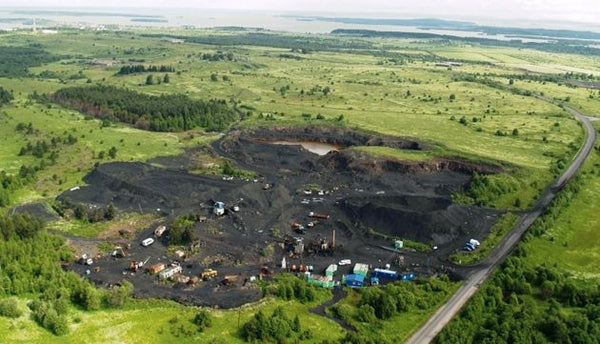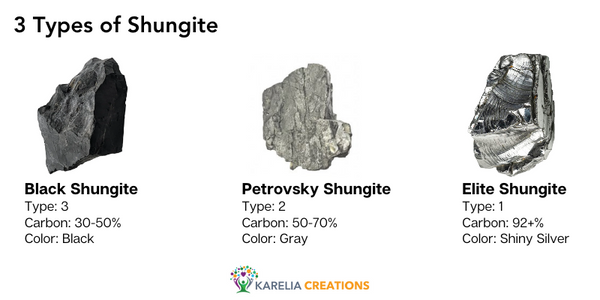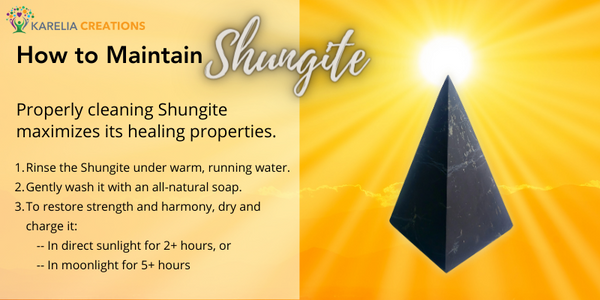Shungite 101 - Get the Facts from Shungite Experts
In the past decade, Shungite has had a lot of interest even being called a modern Miracle Stone of the 21st Century. Needless to say, a lot of false information and cheap imitation soon followed. Shungite experts since 2015, we will set the record straight and help you identify fact from fiction.
What Makes Shungite so Unique?
The physical properties of pure Shungite are vastly different than any other mineral on earth. Shungite is a mineral with the same basic chemical composition as coal (classified as C60 on the mineral scale); however, that is where the similarities stop. Unlike coal, Shungite does not burn, is not effected by pressure and is of a greater hardness - similar to that of the diamond. Shungite is a 2 billion year old mineral formed long before life existed on Earth.
Shungite’s uniqueness comes from the carbon molecule called the Fullerene molecule. Fullerenes attract and neutralize unnatural elements in the environment (such as electromagnetic emissions) that surround us. Click here to read about fullerenes from the US National Institute of Health.
How Did Shungite Form?
Scientists believe that shungite formed from the remains of ancient organisms that lived in the shallow seas that covered the Karelia region over two billion years ago. As these organisms died, their remains settled on the bottom of the sea, where they were subjected to intense heat and pressure over millions of years.
This heat and pressure transformed the organic material into graphite, which eventually turned into the unique form of carbon known as shungite. The process of transformation was aided by the high concentration of minerals in the Karelia region, including silica and iron.
The resulting shungite deposits are found in two main forms: the more common and less pure "regular" shungite, and the rarer and highly pure "elite" shungite. Elite shungite is believed to have formed under even more extreme conditions, with higher temperatures and pressures than regular shungite.
When was Shungite Discovered?
Shungite has been known to the local people of Karelia, Russia for centuries, but its unique properties were not fully recognized until the 20th century.
The first official report on shungite came in 1878, when a Russian explorer named N. N. Voronkov described a large deposit of the mineral in the village of Shunga in Karelia. However, it was not until the 1930s that Russian scientists began to study shungite in depth.
In the 1950s, Russian scientists discovered that shungite has unique electrical and magnetic properties, leading to extensive research on its potential uses in industry and technology. Today, shungite is widely used in products such as water filters, cosmetics, and EMF protection devices.
Where Can I Find Shungite Deposits?
Shungite is primarily found in the Karelia region of Russia, near the Finland border, specifically in the Shunga village, which is where the mineral gets its name. All of the shungite used for our products are imported directly from the Zazhoginsky deposit of this mine, ensuring authenticity.
Smaller shungite deposits also can be found in other parts of Russia, including the Lake Onega area, the Khibiny Mountains, and the Malyi Vudyavr deposit.

What are the Three Shungite Types?
Shungite stones can be divided into 3 types based on the amount of carbon it contains.

| Type 1, Elite Shungite |
The rarest and purest form. Only 1% of all Shungite found is Type 1. It is 99% organic carbon and has a semi-metallic shiny silver-black finish. It is sometimes called Noble Shungite and has the highest amount of protective, healing energy. The exceptionally high percentage of carbon makes elite crystals extremely fragile. They are are manually dug (not mechanically mined), and they cannot be be shaped or polished. Elite shungite is sold in their unique natural shape. |
| Type 2, Petrovsky Shungite | Can range from 50% to 70% organic carbon. Petrovsky shungite is not sold often because of the desire for the more powerful elite shungite or the versatility of black shungite for jewelry. It is gray in color. |
| Type 3, Black or Regular Shungite | Can range from 30% to 50% organic carbon. It is industrially mined, easily shaped/polished and black in color. It is the Shungite used to make beads, pyramids, and other objects because it is easier to shape and polish to a high shine. |
What is Shungite used for?

- These best-selling shungite products show how they are used the most. Purifying and infusing water with healing energies
- Enhancing the growth in vegetation and livestock
- Lengthening the shelf life of produce in the refrigerator
- Lowering your electrical bill
- Attenuating the energy field of electronic devices emitting EMF, microwave, and other harmful frequencies
- Healing a variety of diseases
- Balancing the energy body that is the blueprint for the physical body promoting physical, emotional, and mental health
- Charging drinking water, bath water & swimming pools with a perfectly pH balanced water
- Protecting and shielding against all types of EMF & electronic fields
What does Shungite Water Taste Like?
Shungite water is said to have a slightly different taste compared to regular water. The taste may vary depending on the concentration of shungite in the water, the quality of the shungite used, and the duration of time the water has been infused with shungite.
Some people describe the taste of shungite water as smooth, refreshing, and slightly sweet. Others say that it has a slightly earthy or mineral-like taste, similar to the taste of natural spring water.
However, it's important to note that the taste of shungite water may be subjective and vary from person to person. Additionally, the taste of shungite water may be influenced by factors such as the source of the water, the temperature of the water, and the individual's own taste preferences.
How Do I Test for Authentic Shungite?
First, look at your Shungite. Real shungite is a natural stone. Don't be alarmed if you find trace minerals, eg quartzite or pyrite, sometimes giving the appearance of a crack (vein) or rust. The unique characteristics enhance the beauty. Don't fall for perfect "shungite," which is likely a manufactured imitation. Trust us. We've been specializing in Shungite since 2015.
Next, try the flashlight test. Authentic shungite is electrically conductive due to its large amount of carbon. Grab your LED flashflight and test it yourself. You can also use an ohmmeter or multimeter, but the flashlight test is as simple as 1-2-3.
- Remove the back of an LED flashlight's battery compartment.
- Place the Shungite against the batteries.
- See the Shungite conduct electrictiy. Our Shungite Shines!

Is Shungite Illegal?
No, shungite is not illegal. Shungite is a natural mineral that is found in the Karelia region of Russia and is legally and ethically mined and sold as a commercial product.
However, it's worth noting that there are some counterfeit shungite products on the market that may not contain genuine shungite or may be adulterated with other materials. To ensure that you are purchasing authentic shungite, it's important to buy from reputable sellers and do your research before making a purchase.
Additionally, some countries may have regulations or restrictions on the import or export of shungite or shungite products. It's always a good idea to check with your local authorities before importing or exporting any mineral or stone product.
How do I maintain my Shungite?
It is important to maintain the healing properties of Shungite by periodically cleaning it. Let it dry under a moon light or in natural sun so that it can absorb the natural energy of the moon or sun. To restore strength and harmony, charge it in direct sunlight for at least 2 hours or in the moonlight for at least 5 hours.


